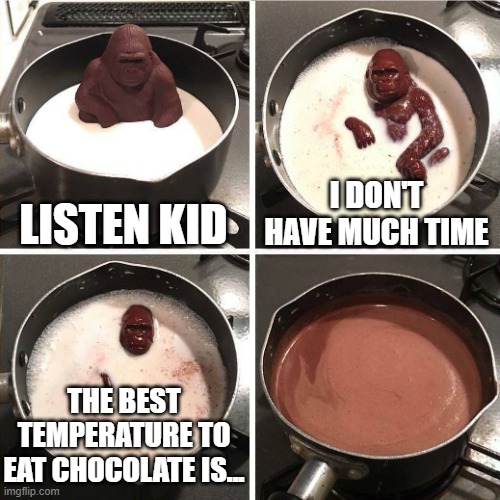Table of Contents (click to expand)
We all love eating chocolate in our own way, but slightly melted chocolate releases its flavors intensely and almost instantly, as compared to cold chocolate.
Try this… before you eat a piece of chocolate that’s been kept in the fridge, place it in the microwave for a few seconds. It doesn’t matter whether it’s white, dark or milk chocolate, just heat it until it is just about soft. Most people agree that it tastes better when it’s slightly soft and melted… what do you think?
I love how warm chocolate just oozes flavor in the mouth and soaks through the tongue, immersing you in its intense flavor. Believe it or not, there is a scientific basis to this warm delight.
What’s So Special About Melted Chocolate?
Put a piece of chocolate in your mouth and let it rest on your tongue for a few seconds. Don’t bite or swallow it. Do you feel that rich, creamy taste intensifying as the seconds pass? The temperature inside our mouths is 37° C (98.6° F), and at that temperature, chocolate starts to melt.
As it melts, the chocolate goes from a solid phase to a semi-liquid phase, mixing with saliva as it dissolves the sugar. The melting sugar, cocoa and milk solids that make up chocolate coat the tongue, exciting your taste buds. As that happens, chocolate also releases its aroma in the mouth, further improving its taste. Over 600 volatile compounds have been identified in chocolate, with some important ones being 3-methylbutanal and 2-methylpropanal. These aromas are also responsible for the typical chocolatey smell.
Premium artisanal chocolate makers add dried nuts or fruits like cranberries, blueberries and pomegranate. This enhances the flavor, as the fruits have aromas and add a sour taste of their own. Another bonus is that these fruits are good antioxidants too, which makes me feel less guilty when I’m disappearing large chocolate bars all by myself.
However, the main flavor comes from the milk fats, which take longer to melt if the chocolate is refrigerated.
Cold chocolate exists as solids pieces and when it’s put inside our mouths, it takes longer for it to melt and release all those heavenly flavors. The chocolate doesn’t melt in time before we chew and swallow it, so we often miss out on the good stuff!

The best-tasting chocolates have a firm texture and a creamy thickness that leaves a pasty mouth feel. The remnants left in the mouth continue to provide that chocolatey taste we so dearly enjoy. It all boils down to the flavor compounds released in the mouth and nose, which happens as the chocolate melts and breaks in your mouth.
Also Read: Why Do We Like Chocolate So Much?
What Is The Best Temperature At Which To Eat Chocolate?
Unfortunately, no one has conducted a study where loads of people are taken and made to eat chocolate at different temperatures. If a study like this ever happens, sign me up!
There isn’t one temperature value that’s best to eat chocolate… it’s more complicated than that.
Chocolate comes in different physical forms, depending on the composition and processing techniques. For example, adding milk solids lowers the melting point of chocolate.
Chocolate has six different molecular crystalline structures: forms I – VI. These forms are made by heating and cooling the chocolate at different temperatures. Form V is the most desired form, as it has the best texture, shine and form. Form V chocolates melt at 92.84° F (33.8° C), meaning they can melt in the mouth easily.
This doesn’t mean that melting chocolate in the microwave for 1 minute until it’s basically a liquid will make it taste best. At higher temperatures, the sugar and milk solids will just melt, so it will feel like you’re just swallowing chocolate syrup. It will remove the nice mouth feel of eating thick and creamy chocolate.
Remember, the darker the chocolate, the higher the melting point. At room temperature, milk chocolate will have a softer texture than dark chocolate. If you’re a dark chocolate lover, you can simply keep it in your mouth for longer, until all the flavors ooze out. However, on average, eating any chocolate at temperatures between 93.2-104° F (34-40° C) should make them much more enjoyable.
However, if you like to savor your chocolates, it’s better to store them at a constant temperature; avoid cooling and warming them, as that can cause the milk fats to bloom. That’s when you see white spots all over your chocolate bar. It’s still just as tasty, but the appearance and texture will change.

Also Read: Why Does Food Taste Different When It’s Cold Vs. When It’s Hot?
Conclusion
There is a lot of research that goes into chocolate making. There is also plenty of material science involved in optimizing the shape, the nature of sugar, milk fats and solids, and the type of cocoa to make the very best-tasting chocolate. The Belgians and Swiss deserve a lot of credit for their hard work in making the best chocolates in the world.
The latest research focuses on making chocolates by combining three essential factors: shape, melting rate and air volume. The idea is to design the best chocolate shapes that melt quickly in the mouth, so that the flavorful compounds are carried effectively by air through the mouth so that we perceive the most delicious taste possible!
How well do you understand the article above!

References (click to expand)
- Paixão, J. A., Rodrigues, J. B., Esmerino, E. A., Cruz, A. G., & Bolini, H. M. A. (2014, December). Influence of temperature and fat content on ideal sucrose concentration, sweetening power, and sweetness equivalence of different sweeteners in chocolate milk beverage. Journal of Dairy Science. American Dairy Science Association.
- Afoakwa, E. O., Paterson, A., & Fowler, M. (2007, June). Factors influencing rheological and textural qualities in chocolate – a review. Trends in Food Science & Technology. Elsevier BV.
- Lenfant, F., Hartmann, C., Watzke, B., Breton, O., Loret, C., & Martin, N. (2013, May). Impact of the shape on sensory properties of individual dark chocolate pieces. LWT - Food Science and Technology. Elsevier BV.
- Beckett, S. T. (2003, August). Is the taste of British milk chocolate different?. International Journal of Dairy Technology. Wiley.
- Fryer, P., & Pinschower, K. (2000, December). The Materials Science of Chocolate. MRS Bulletin. Springer Science and Business Media LLC.
- Nightingale, L. M., Cadwallader, K. R., & Engeseth, N. J. (2012, April 27). Changes in Dark Chocolate Volatiles during Storage. Journal of Agricultural and Food Chemistry. American Chemical Society (ACS).
